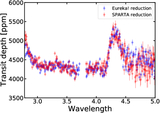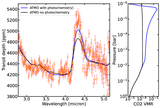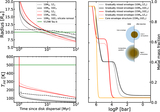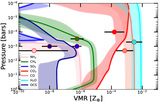Image Details

Caption: Figure 5.
Transmission spectrum of V1298 Tau b observed with JWST/NIRSpec G395H and HST/WFC3 (Section 4.1), with 1σ error bars, along with some models which were nominally expected based on the published RV mass (A. Suárez Mascareño et al. 2021), equilibrium temperature, predicted internal temperature from evolution models (Figure 7), and the mass–metallicity relation for core-accretion formation (D. P. Thorngren et al. 2016). The blue solid line shows the best-fit model from the PICASSO free retrieval (see Section 4.1 and Appendix D), and the shaded region around it shows the 1σ confidence interval. The black solid line shows a model with 12 M⊕, 100× solar (assumed from the mass–metallicity relation) and Tint = 500 K, which can be ruled out at a 23σ confidence level. The model rejection significance is estimated from the difference in χ2 values between the best-fit model (blue) and the model being compared. The black dotted line shows a solar metallicity, 80 M⊕ (2σ mass lower limit from A. Suárez Mascareño et al. 2021) model, which can also be ruled out at a 30σ confidence level. A hazy atmospheric model (tholin haze) with a haze formation efficiency of 0.01% and 12 M⊕ can be ruled out at 38σ confidence level as it produces a strong slope and a feature at 3.3 μm, which is not seen. The red dashed line shows a 12 M⊕, 10x solar metallicity model with an internal temperature of 100 K, and can be ruled out at 18σ confidence level as it produces a strong methane absorption feature at 3.3 μm. The red solid line is the best-fit model from the HST transmission spectrum (S. Barat et al. 2024b), extrapolated to JWST wavelengths. It has 23 M⊕, solar metallicity, Tint = 400 K. This model is simulated using PetitRadtrans. This model matches the water and methane features in NRS1; however, it underpredicts the size of the CO2 feature, most likely due to a higher mass, lower metallicity, and no photochemistry. All the models presented in this figure have a gray cloud deck at 0.01 bar.
Copyright and Terms & Conditions
© 2025. The Author(s). Published by the American Astronomical Society.












